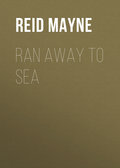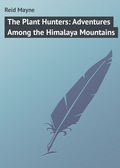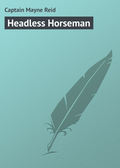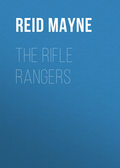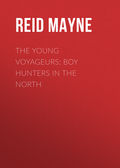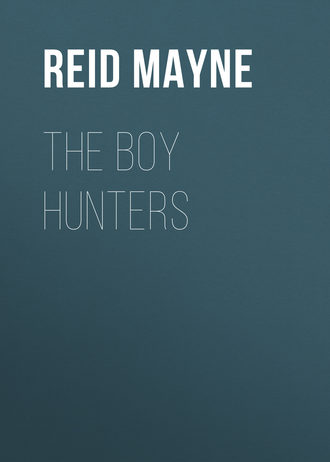
Майн Рид
The Boy Hunters
Chapter Eleven.
The Chain of Destruction
Directly in front of the tent, and at no great distance from it, a thick network of vines stretched between two trees. These trees were large tupelos, and the vines, clinging from trunk to trunk and to one another, formed an impenetrable screen with their dark green leaves. Over the leaves grew flowers, so thickly as almost to hide them – the whole surface shining as if a bright carpet had been spread from tree to tree and hung down between them. The flowers were of different colours. Some were white and starlike, but the greater number were the large scarlet cups of the trumpet-vine (bignonia).
François, although listening to his brother, had for some time kept his eyes in that direction, as if admiring the flowers. All at once, interrupting the conversation, he exclaimed, —
“Voilà! look yonder – humming-birds!”
Now the sight of humming-birds is not so common in America as travellers would have you believe. Even in Mexico, where the species are numerous, you will not see them every day. Indeed, you may not notice them at all, unless you are specially looking for them. They are such small creatures, and fly so nimbly – darting from flower to flower and tree to tree – that you may pass along without observing them, or perhaps mistake them for bees. In the United States, however, where only one species has yet been noticed, the sight is a rare one, and generally interesting to those who witness it. Hence François’ exclamation was one of surprise and pleasure.
“Where are they?” inquired Lucien, starting up in an interested manner.
“Yonder,” replied François, “by the trumpet flowers. I see several, I think.”
“Softly, brothers,” said Lucien; “approach them gently, so as not to fright them off – I wish to make some observations upon them.”
As Lucien said this, he walked cautiously forward, followed by Basil and François.
“Ah!” exclaimed Lucien, as they drew near, “I see one now. It is the ruby-throat (Trochilus colubris). He is feeding on the bignonias. They are fonder of them than any other blossoms. See! he has gone up into the funnel of the flower. Ha! he is out again. Listen to his whirring wings, like the hum of a great bee. It is from that he takes his name of ‘humming-bird.’ See his throat, how it glitters – just like a ruby!”
“Another!” cried François; “look above! It is not near so pretty as the first. Is it a different species?”
“No,” replied Lucien, “it is the female of the same; but its colour is not so bright, and you may notice that it wants the ruby-throat.”
“I see no others,” said François, after a pause.
“I think there are but the two,” remarked Lucien, “a male and female. It is their breeding season. No doubt their nest is near.”
“Shall we try to catch them?” inquired François.
“That we could not do, unless we had a net.”
“I can shoot them with small shot.”
“No, no,” said Lucien, “the smallest would tear them to pieces. They are sometimes shot with poppy-seeds, and sometimes with water. But never mind, I would rather observe them a bit as they are. I want to satisfy myself upon a point. You may look for the nest, as you have good eyes. You will find it near – in some naked fork, but not among the twigs or leaves.”
Basil and François set about looking for the nest, while Lucien continued to watch the evolutions of the tiny little creatures. The “point” upon which our young naturalist wished to be satisfied was, whether the humming-birds eat insects as well as honey – a point which has been debated among ornithologists.
As he stood watching them a large humble-bee (Apis bombylicus) came whizzing along, and settled in one of the flowers. Its feet had scarcely touched the bright petals, when the male ruby-throat darted towards it, and attacked it like a little fury. Both came out of the flower together, carrying on their miniature battle as they flew; but, after a short contest, the bee turned tail, and flew off with an angry-like buzz, – no doubt, occasioned by the plying of his wings more rapidly in flight.
A shout from François now told that the nest was discovered. There it was, in the fork of a low branch, but without eggs as yet – else the birds would not both have been abroad. The nest was examined by all three, though they did not disturb it from its position. It was built of fine threads of Spanish moss (Tillandsia), with which it was tied to the branch; and it was lined inside with the silken down of the anemone. It was a semi-sphere, open at the top, and but one inch in diameter. In fact, so small was the whole structure, that any one but the sharp-eyed, bird-catching, nest-seeking François, would have taken it for a knob on the bark of the tree.
All three now returned to watch the manoeuvres of the birds, that, not having seen them by the nest, still continued playing among the flowers. The boys stole as near as possible, keeping behind a large bunch of hanging vines. Lucien was nearest, and his face was within a few feet of the little creatures, so that he could observe every motion they made. He was soon gratified with a sight that determined his “point” for him. A swarm of small blue-winged flies attracted his attention. They were among the blossoms, sometimes resting upon them, and sometimes flitting about from one to another. He saw the birds several times dash at them with open bills, and pick them from their perch; so the question was decided – the humming-birds were insect-eaters.
After a while the female flew off to her nest, leaving the male still among the flowers.
The curiosity of the boys was now satisfied, and they were about to return to the tent, when Lucien suddenly made a motion, whispering the others to remain silent. François first caught sight of the object which had caused this behaviour on the part of his brother, and then Basil saw it. A hideous object it was!
Crouching among the leaves, now crawling sideways, now making short springs, and then hiding itself, went a fearful-looking creature. It was about the size of one of the birds, but far different in appearance. Its body consisted of two pieces, joined about the middle, and covered all over with a reddish-brown wool or hair, that stood upright like bristles. It had ten limbs – long, crooked, and covered with hair, like the body – two curved claw-like antennae or feelers in front, and two horns projecting behind, so that, but for the sharp fiery eyes of the creature, it would have been difficult to tell its head from its hinder part. Its rusty colour, its ill-shaped body, and hairy legs, combined with the piercing look from its eyes, gave it a most vicious appearance, such as belongs, less or more, to all of its race – for it was of the race aranea, or spiders.
“The leaping tarantula!” whispered Lucien to his brothers. “See,” he continued, “it is after the ruby-throat!”
This was evident. Step by step, and leap after leap, it was approaching the cluster of blossoms where the humming-bird was at the moment engaged. Its eyes were bent eagerly upon the latter; and whenever it flew up from the flowers and whirred idly about, the tarantula squatted itself closely, hiding behind the leaves or shanks of the vines. On the other hand, when the bird settled a moment and appeared busily feeding, the skulking creature would advance a stage nearer, either by a quick run or a leap, when it would again conceal itself and await a fresh opportunity. As the bird flitted about a good deal, the spider had frequently to change its direction in following. The former after one of its short flights, settled into a pet-flower directly in front of where the latter lay crouching. It did not enter the cup of the flower, but remained at the mouth – poised upon its whirring wings – while with its long prehensile tongue it drew out the honey. It had scarcely been a moment in this position, when the tarantula sprang forward and clutched it round the body with his antennae. The bird, with a wild chirrup, like that of a distressed cricket, flew outward and upwards. Its wings were still free, and all expected it would carry off the spider that was now seen clinging around it. Not so, however. On getting a few feet from the flower its flight appeared to be suddenly checked; and, although it still kept in the air, flying first one way and then another, it was evident that something restrained it from getting clear off. On looking more attentively a fine silk-like line was seen stretching from the trees to the fluttering creature. It was the thread of the spider, and this it was that prevented his victim from carrying him into the air.
The little wings soon ceased to move, and both bird and spider fell to the end of the thread, where they hung for a moment suspended. The boys could see that the bird was dead, and the mandibles of the tarantula were buried in its shining threat!
François would have rushed forward to kill the destroyer; but Lucien, who was too ardent a naturalist to have his lesson thus interrupted, restrained his more impetuous brother, and all three remained quiet as before.
The tarantula now commenced reeling in his line, for the purpose of carrying his prey up among the branches, where he had his nest. The boys looked upward to discover the latter. There, sure enough, was the web, in a shaded corner, stretching its meshes from a large liana to the trunk of the tupelo; and towards this point the spider now slowly progressed with his lifeless victim.
As they watched his motions, their eyes were caught by a shining object that moved along the wrinkled bark of the liana. As the vine was nearly a foot in diameter, and of a deep ferruginous colour, this object was the more apparent against its dark ground, for it was a creature of brilliant hues. It was an animal of the lizard species; and if any lizard could be considered beautiful, this one might have been so called. But the hideous, half-human form of these animals, their piercing looks, their stealthy and predatory habits, and, above all, the knowledge that the bite of several of their species is poisonous, combine to render them objects that excite disgust and awe, rather than admiration.
This one, as we have already said, was of the most brilliant colour. The whole of its upper surface was a golden green, vivid as the hues of an emerald; while its body underneath was greenish-white. But this part, as it lay along the liana, was not seen; and a pure, uniform green was the apparent colour of the whole animal. There was one conspicuous exception – the throat. This was swollen out, as though by inflation, exhibiting a surface of the brightest scarlet, that appeared in the sun as if painted with vermilion. The eyes of the animal shone like flame – for the irides were, in fact, the colour of burnished gold, with small pupils, sparkling like diamonds, in their midst. Its arms and limbs were of the same colour as the body; and its branching feet exhibited the peculiarity of having small knots or tubercules at the ends of the toes. These tubercules, together with the loose dewlap of the throat, told the genus to which the animal belonged, – an anolius of the family Iguanidae, and the only species of the anolius found in the territory of the United States.
These facts were communicated by Lucien to his brothers in a whisper, while they were observing the creature on the liana. Basil and François had often seen the species before, and were familiar with it under the names of “green lizard” and “chameleon,” – both of which names are applied to it in common phraseology. The animal was not over six inches in length; and its long coffin-shaped head, and slender, whip-like tail, were at least two-thirds of this extent. When first noticed, it was passing up the liana, for the latter slanted upwards between the trees. It did not see the boys; or, at all events, did not regard their presence – for the chameleon is a bold little animal, and is not afraid of man. Up to this time it had not seen the tarantula either. As it was passing onward, its eyes fell upon the latter as he climbed up his silken ladder. All at once the lizard stopped, and put itself into a crouching attitude. Its colour suddenly changed. The vermilion throat became white, and then ashy pale; and the bright green of its body faded into dark brown or rust colour, until it was difficult to distinguish the animal from the bark of the liana! Had the eyes of the spectators not been already fixed upon it, they might have supposed that it had disappeared altogether. After crouching for a few seconds, it seemed to have formed its plan of attack – for it was evident that it meant to attack the spider – such, with flies and other insects, being its natural food and prey. It passed to the opposite side of the liana, and then proceeded upward, making for the nest of the tarantula. It reached this point by a single run, although its back was downward as it crawled. This it could easily do by means of the tubercules upon its toes – which enable lizards of the genus anolius to walk upon perpendicular walls, up glass windows, or along the smoothest ceilings.
For some moments it lay quiet in a crouching attitude, waiting the approach of the spider, that, busied with his own affairs, did not dream of a lurking foe so near him. The tarantula was, no doubt, in high spirits at the moment, exulting at the prospect of the banquet of blood he should have, when he had carried the ruby-throat to his dark, silken cave. But he was destined never to reach that cave. When he had got within a few inches of its entrance, the chameleon sprang out from the limb, seized the spider in his wide jaws, and all three – lizard, spider, and bird – came to the ground together. The bird was let go in the fall, and became separated from the others. Between these there was a short struggle over the grass – for the tarantula fought fiercely; but he was no match for his antagonist; who, in a few moments, had ground off his legs with his powerful jaws, and left him a helpless and motionless trunk. The chameleon now seized his victim by the head, sunk his sharp, conical teeth into its skull, and thus killed it outright.
What appeared singular to all was, that the moment the lizard had first sprung upon his prey his bright colours returned like a flash, and he again appeared with his green back and red throat, if possible more brilliant than ever.
He now commenced dragging the body of the spider over the grass, evidently making for some decayed logs, half covered with vines and briars, that formed a heap near the spot. Here, no doubt was his retreat.
This time François did not attempt to interfere. He had no desire to do so. He looked upon the death of the tarantula as a just punishment; moreover, the chameleon, from its fine colours, its sportive habits, and its harmlessness – so far as man is concerned – is a general favourite with all; and it was so with François. In fact, François, as well as his brothers, who had often watched this little creature gambolling among the leaves, and feeding upon flies and other small insects, had never seen it exhibit so much ferocity before. Notwithstanding this, they all applauded it for killing the hideous tarantula; and so far as they were concerned, it might have carried the body to its hole without being molested. It was destined, however, to meet with interruption from another quarter. François, whose quick eyes were wandering about, suddenly exclaimed, —
“Look – brothers, look! A scorpion-lizard!”
Basil and Lucien cast their eyes where François pointed – up to the trunk of a tree that rose over the spot where the chameleon was crawling. About twenty feet from the ground was a dark, round hole, evidently the former nest of the red-bellied woodpecker (Picus Carolinus). The birds, however, who made that nest had deserted it; for it was now occupied by a creature of a far different kind – a scorpion-lizard – whose red head and brown shoulders at the moment protruded from the hole.
All who have travelled the great American forests are familiar with such a sight – for this animal may be often observed in similar situations. A more disagreeable sight is rarely met with. The scorpion-lizard, with his red head and olive-brown body, is a hideous-looking reptile at best; but when thus peering from his gloomy tree-cave, moving his pointed snout from side to side, his dark eyes glancing all the while with a fierce, malignant expression, it is difficult to conceive a more vicious-looking creature.
His head was in motion when François spake – for it was this that had caught the eye of the boy. It was moving from side to side, protruded out from the hole, the snout pointing downwards. The animal was watching the ground below, and evidently preparing to issue forth, and come down. The chameleon, rustling over the dead leaves, had attracted his attention.
As quick as lightning his whole body appeared upon the tree, and lay flat along the bark, head downwards. Here he halted for a moment; then, raising his shoulders, he ran nimbly down the trunk, and rushing outwards, sprang upon the chameleon. The latter, thus suddenly attacked, dropped the spider; and at first showed an intention of retreating. Had he done so the scorpion would have followed him no farther – as its only object in attacking him was to rob him of his prey. The chameleon, however, is a courageous little animal; and seeing that his assailant was not much bigger than himself – for the animal in question was one of the smallest of the skink family – he turned again and showed fight. His throat swelled to its largest extent, and grew brighter than ever.
Both now stood facing each other, and about twelve inches apart, in threatening attitudes. Their eyes sparkled; their forked tongues shot forth, glittering in the sun; and their heads at intervals rose and fell, in a manoeuvring manner, like a pair of pugilists “coming to the scratch!”
After a short while they sprang at each other open-jawed; wriggled over the ground a moment – their tails flying in the air – then separated, and again assumed their defiant attitudes, manoeuvring as before. In this manner they met and parted several times, neither seeming to have gained much advantage.
The weakest part of the green lizard lies in his tail. So tender is this appendage that the slightest blow of a small switch will separate it from the body. The skink seemed to be aware of this fact, as he several times endeavoured to get around his antagonist, or, in military phraseology, to “turn” him. It was evidently his intention to attack the tail. This the chameleon dreaded; and was equally desirous not to be “outflanked.” In whatever way the skink manoeuvred, his antagonist met him with his scarlet front.
For several minutes the battle raged – these little creatures exhibiting as much fury and fierceness as if they had been a pair of great crocodiles. The chameleon at length began to show symptoms of giving out. The throat grew paler – the green became less vivid – and it was evident that he was getting the worst of it. The scorpion now made a rush, and threw the other upon his back. Before the chameleon could recover himself, his antagonist seized his tail, and bit it off close to the body. The poor little fellow, feeling that he had lost more than half his length, scuttled away, and hid himself among the logs.
It was well for him, as it proved afterwards, that he got off, even thus mutilated; and it would have been better for the skink had he remained in his hole. The battle between the two had carried them some distance from the spot where it first commenced, and under the leafy, spreading branches of a mulberry-tree. While the fight was raging, a slight movement in the leaves above had attracted the attention of the boys. The next moment a red object was thrust downward, until a foot or so of it appeared hanging clear of the branches. It was about the thickness of a walking-cane; but the glistening scales and the elegant curving form told that this singular object was a serpent.
It did not remain stationary. It was slowly and gradually letting itself down – for more of its body was every moment becoming visible, until a full yard of it hung out from the leaves. The remainder was hidden by the thick foliage where its tail no doubt was coiled around a branch. That part of the body that was seen was of a uniform blood-red colour, though the belly or under side was much the lightest.
“Voilà!” muttered François, “what a red snake! I never saw such before.”
“Nor I either,” added Basil.
“Nor I,” said Lucien, “but I have heard of it. I easily recognise it from the description. It is the ‘red snake’ of the Rocky Mountains (Coluber testacea).”
“Oh,” said Basil, “I have heard trappers speak of it.”
“Yes,” added Lucien. “It is a rare species, and only found in the Far West. See! the scorpion has whipped. The chameleon is running off, and, as I live, without its tail!”
The skink at this moment perceived the long, red body of the serpent dangling above him; and knowing from experience a terrible enemy, ran off, endeavouring to hide himself in the grass. Instead of making for a tree – where he might have escaped by his superior nimbleness – his confusion and terror led him out into the open ground. The snake dropped from the mulberry and glided after, with his head raised high in the air, and his jaws wide open. In a second or two he overtook the lizard; and striking forward and downward, killed it upon the spot.
Lucien was in raptures with the interesting lesson he was receiving; and again restrained François from rushing forward. They all, however, crept a little nearer – so as the better to observe the further movements of the serpent. They kept as well as possible behind the screen of leaves and bushes.
The snake, after having killed the lizard, remained out in the open ground; and, stretching himself along the grass, commenced devouring it. Snakes do not masticate their food. Their teeth are not formed for this, but only for seizing and killing. The blood-snake is not venomous, and is, therefore, without fangs such as venomous snakes possess. In lieu of these he possesses a double row of sharp teeth; and, like the “black snake,” the “whip,” and others of the genus coluber, he is extremely swift, and possesses certain powers of constriction, which are mostly wanting in serpents of the venomous tribes. Like all the others, he swallows his prey just as he kills it – whole. So with the one in question. Having placed the nose of the lizard vis-à-vis with his own, he opened his jaws to their full extent, took in the head, and commenced gradually sucking the body down his throat. It was a curious operation; and the boys watched it with feelings of interest.
But other eyes were bent upon the reptile. His bright blood-coloured body lying along the grass had caught the far-seeing eye of an enemy, whose dark shadow was now seen moving over the ground. On looking up, the boys beheld a large bird wheeling in the air. Its snow-white head and breast, the far spread, tapering wings, but, above all, the long forked tail, told them at a glance what bird it was. It was the great Southern kite (Falco furcatus).
When first seen he was sailing in circles, – or rather in a spiral curve, that was constantly contracting downward and inward. The centre of that curve was the spot occupied by the snake.
It was a beautiful sight to behold this creature cutting the thin air. His flight was the beau idéal of ease and gracefulness – for in this no bird can equal the kite. Not a stroke of his long pointed wings betrayed that he needed their assistance; and he seemed to glory that he could navigate the air without them. Besides, the motion of these, had he used them, might have caught the eye of his intended victim, and warned it of the danger. I say it was a beautiful sight to watch him as he swam through his aery circles, at one moment appearing all white – as his breast was turned to the spectators – the next moment his black back and purple wings glittering in the sun, as sideways he guided himself down the spiral curve. It was a beautiful sight, and the young hunters stood gazing with silent admiration.
Basil and François wondered that he did not at once pounce upon the snake, for towards it his flight was evidently tending. They had seen other hawks do this – such as the red-tailed, the peregrine, and the osprey – which last sometimes shoots several hundred feet perpendicularly down upon its prey. Lucien, however, knew better. He knew that that feat can be performed only by those hawks whose tails are full and not forked, as the bald eagle, and the species already named – their spreading tails giving them the power to suddenly arrest the downward motion, and prevent them from dashing themselves against the earth. The kites, on the other hand, have not that power; and in this arrangement Lucien could perceive a beautiful adaptation of Nature – an equalising of advantages between these two kinds of birds. He reasoned thus: —
The hawks, although swift of wing, and capable of extended flight, cannot remain long in the air. They grow weary and need rest, which they take, perching themselves upon some tree. It may be observed, moreover, that they choose dead trees that overlook an open space. They do so, in order that the leaves may not obstruct their vision – thus giving them a wider range, and, consequently, a better chance of espying their prey. But even with this advantage their chances of seeing their prey are circumscribed, when compared with that of hawks upon the wing; and they are frequently compelled to take to the air in order to discover it.
Now the kites are always in the air, or nearly so. They, in fact, live upon the wing, eating their food as they fly, from their claws. Living thus, they have many more chances of seeing their prey than their cousins of the hawk species; and were they possessed of the power to pounce upon it with as much certainty as the latter do, it is evident they would have greatly the advantage. The want of that capability, however, brings them upon an equality; and, as I have said, Lucien perceived in this that peculiar equilibrium, or “balance of power,” which constantly presents itself to the student of Nature.
These thoughts passed through his mind at the moment. They occupied but a moment however – for it was but a few seconds from the time the kite was first noticed wheeling high in the air, until he swept along the tops of the low trees, so close that the boys could distinguish the red iris of his glistening eyes.
Now, for the first time, the snake caught sight of him. Hitherto it had been too much occupied with its own prey, which it had succeeded in swallowing. The shadow of the broad wings fell upon the sunlit sward directly before its eyes. It looked up, and saw its terrible enemy. It seemed to shiver through its whole length, and turn paler in colour. It struck its head into the grass, endeavouring to hide itself. It was too late. The kite swooped gently downward; and, with open claw, poised himself a moment over the spot. As he rose again, the reptile was seen wriggling in his talons!
A few strokes of his bold wing carried the kite upward, above the tops of the tallest trees; but he was observed to fly heavily. As he rose higher, the flapping of his wings became more hurried and irregular. It was evident that something was impeding his flight. The snake was no longer hanging from his talons. The reptile had twined itself around his body; and its glistening folds, like red bands, could be seen half-buried in the white plumage of the bird!
All at once the kite began to flutter – then one of his wings disappeared; and, notwithstanding the hurried flapping of the other, both bird and serpent fell heavily to the earth!
They fell close to the spot from whence they had risen. Neither was killed by the fall, nor, to all appearance, hurt; for, the moment after they had touched the ground, both were seen engaged in a violent struggle – the bird evidently endeavouring to free himself from the folds of the reptile, while the latter seemed equally bent upon holding him! The snake knew well that this was its only hope; for, should it unfold itself and endeavour to escape, it would only give the kite an opportunity of clutching it a second time, when he would be certain to do it with more fatal effect. It was because the reptile had buried its head in the grass that the kite had failed in seizing it properly by the neck, and putting an end to it at once.
This, no doubt, was the idea of the snake; but it is probable that its antagonist at the moment would have been delighted to “cry quits” with it, for the bird was in a worse “fix” than it was. As things stood, the serpent had undoubtedly the advantage.
It was likely to prove a protracted struggle; for, although there was much twisting and wriggling over the ground, and flapping of the odd wing – that was still free – very little change for a long time appeared to take place in the relative position of the combatants. This could be seen, whenever they paused to rest themselves – which they did every two or three minutes.
How was it to end? The kite could not kill the snake, for he could not get at it, either with his beak or talons. The hold which he had at first taken he had lost, in his attempts to save himself from falling; and he was now unable to renew it, so closely was the reptile warped around him. The snake, on the other hand, could not kill the kite; for, although possessed of considerable powers of constriction, they were not sufficient. It was strong enough to hold, and, perhaps, squeeze its antagonist, but not strong enough to crush and kill him.
Though each, no doubt, at the moment wished to be far enough from the other, they could not separate with safety to both. The kite could not get away, and the snake dared not let him go!
How, then, was the affair to end, in the event that no third party should interfere? This was the conjecture of our adventurers, as with curious eyes they watched this singular contest. The train of reasoning was as follows: —



